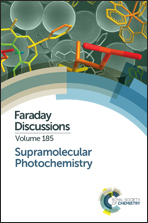Comparison of self-assembled and micelle encapsulated QD chemosensor constructs for biological sensing†
Abstract
Whereas a variety of covalent conjugation strategies have been utilized to prepare quantum dot (QD)-based nanosensors, supramolecular approaches of self-assembly have been underexplored. A major advantage of self-assembly is the ability to circumvent laborious synthetic efforts attendant to covalent conjugation of a chemosensor to functionalized QDs. Here, we combine a CdSe/ZnS core–shell QD with gold(III) corroles using both self-assembly and micelle encapsulation to form QD nanosensors. Appreciable spectral overlap between QD emission and corrole absorption results in efficient Förster resonance energy transfer (FRET), which may be initiated by one- or two-photon excitation. The triplet state of the gold(III) corroles is quenched by molecular oxygen, enabling these constructs to function as optical O2 sensors, which is useful for the metabolic profiling of tumours. The photophysical properties, including QD and corrole lifetimes, FRET efficiency, and O2 sensitivity, have been determined for each construct. The relative merits of each conjugation strategy are assessed with regard to their implementation as sensors.
- This article is part of the themed collection: Supramolecular Photochemistry

 Please wait while we load your content...
Please wait while we load your content...